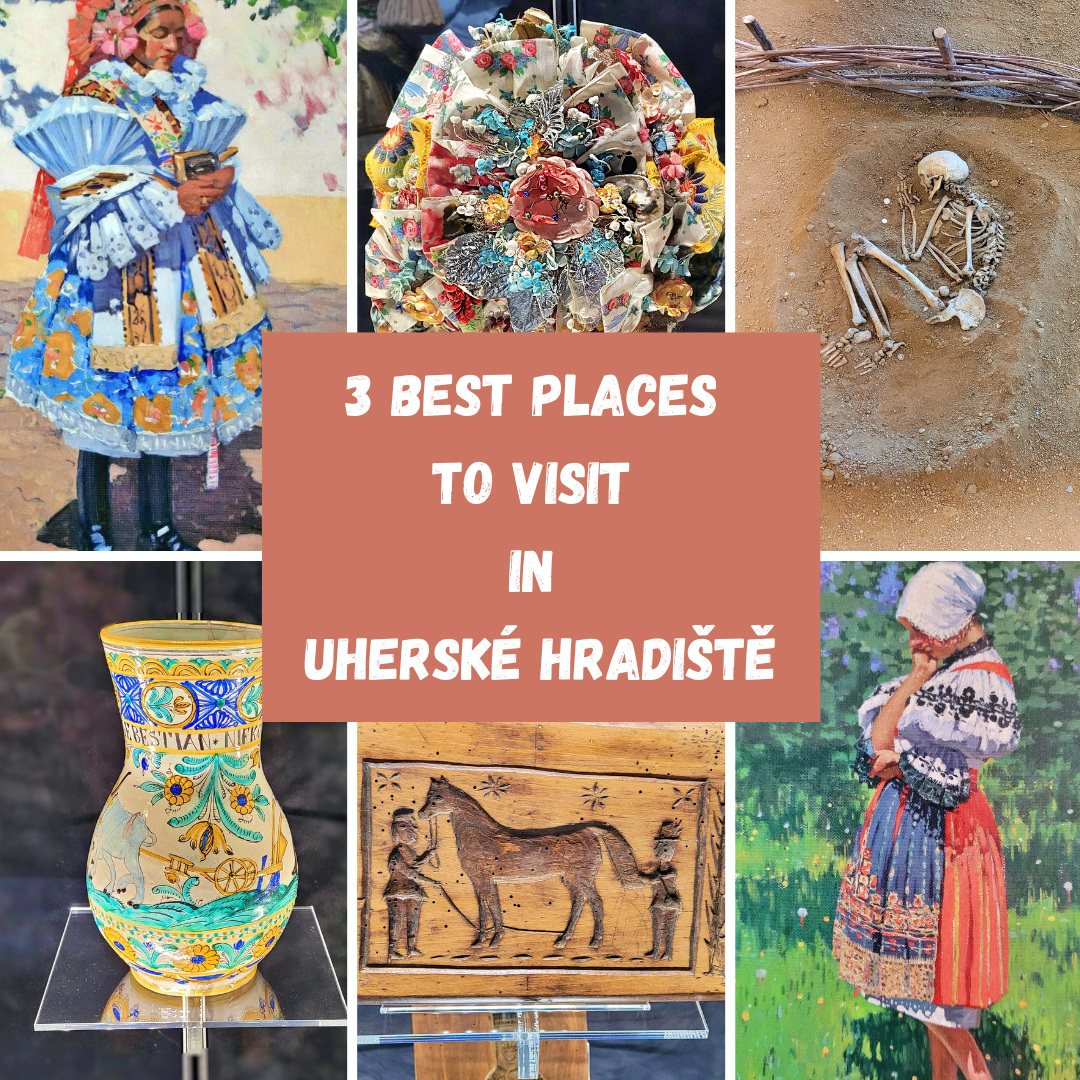
Uherské Hradiště is the heart of Slovácko and is located on the Morava River. The last time I was in the town was when I was a little girl. That made me look forward to coming here all the more. It has a very nice historical centre. If you want to get a closer look at the rich Slovak folk traditions, you are in the right place.
1. GALLERY OF JOŽA UPRKA
In case you are at least a little bit interested in art, you should not miss this gallery. It is really unique. It is located in the Slovak Centre of Culture and Traditions. If you come to the city by train, it is only a few steps to Masaryk Square, where the gallery is located.

I like the paintings of the painter Joža Uprka very much. Maybe because I like French impressionists. In his paintings I always admired the girls and women in colourful, colourful costumes. It was a magical encounter in the gallery. Figures from the paintings seemed to emerge from the frames and fill the lavish gallery space.
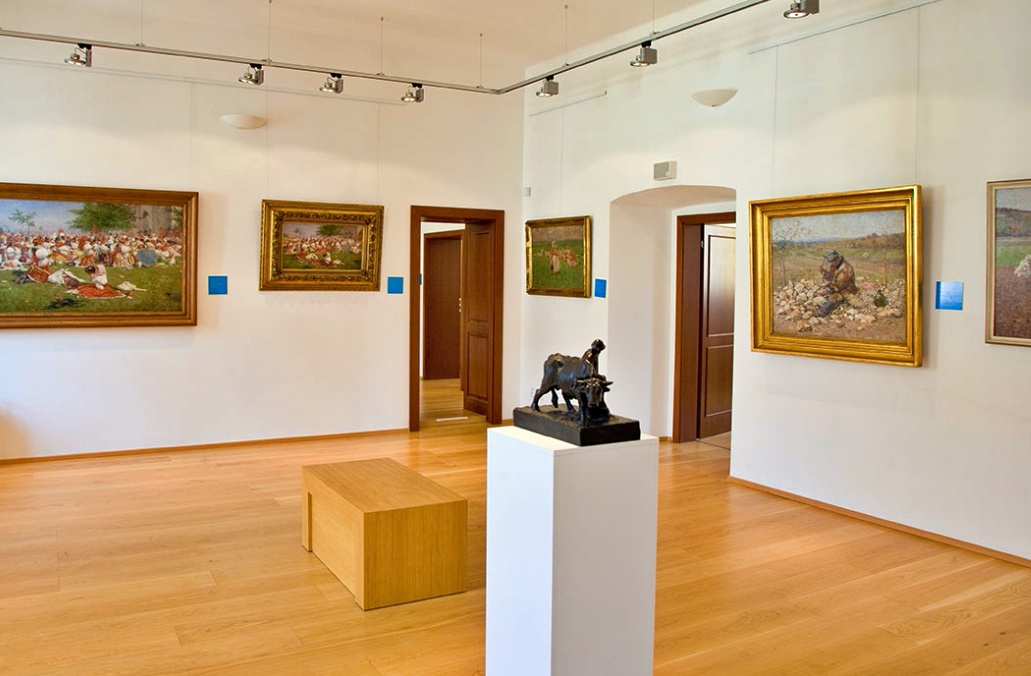
Since you are not allowed to take pictures of the paintings in the gallery, you will only find pictures of the postcards I bought there in this article.
Uprka was completely obsessed with costumes and fur coats and you can find him in all his pictures. He captured costumes from Kyjov, Kunovice, Ostrožsko, Veselsko or Horňácko. For me, he was such a documentarist and ethnographer who painted his native region. He managed to capture the local landscape, but also the people who worked in the fields. He masterfully managed to capture the atmosphere of pilgrimages and folk festivals. He was fortunate to have lived at a time when costumes were commonly worn.

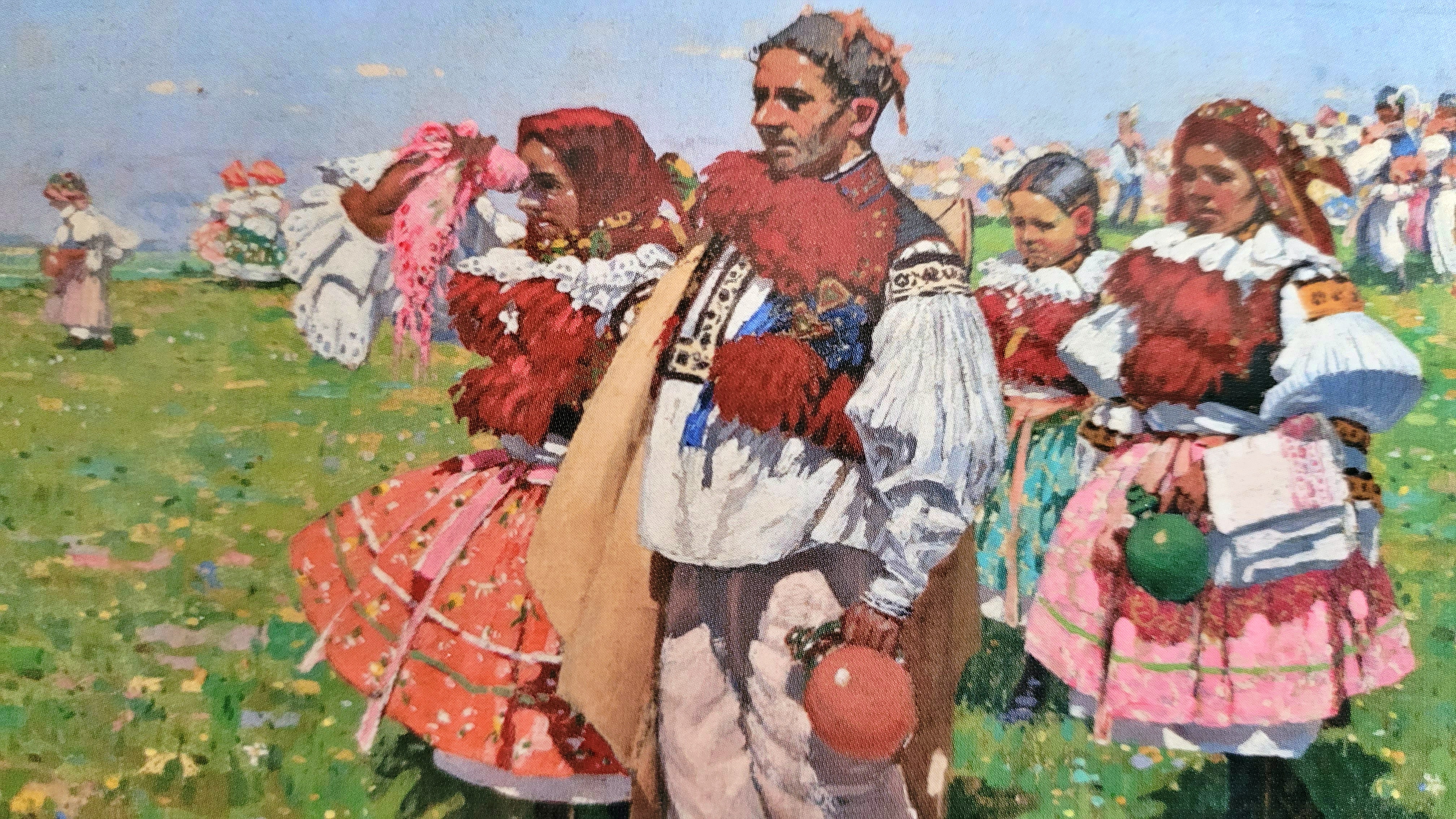
We were almost alone in the gallery. We were able to admire the paintings in peace, but also to see photographs from his life in the spacious corridors.
I think his most famous painting is Pilgrimage to St. Anthony. He was 31 years old when he painted it. At first, this painting was disliked in Prague, but eventually he won the gold medal of the Czech Academy of Sciences and Arts.
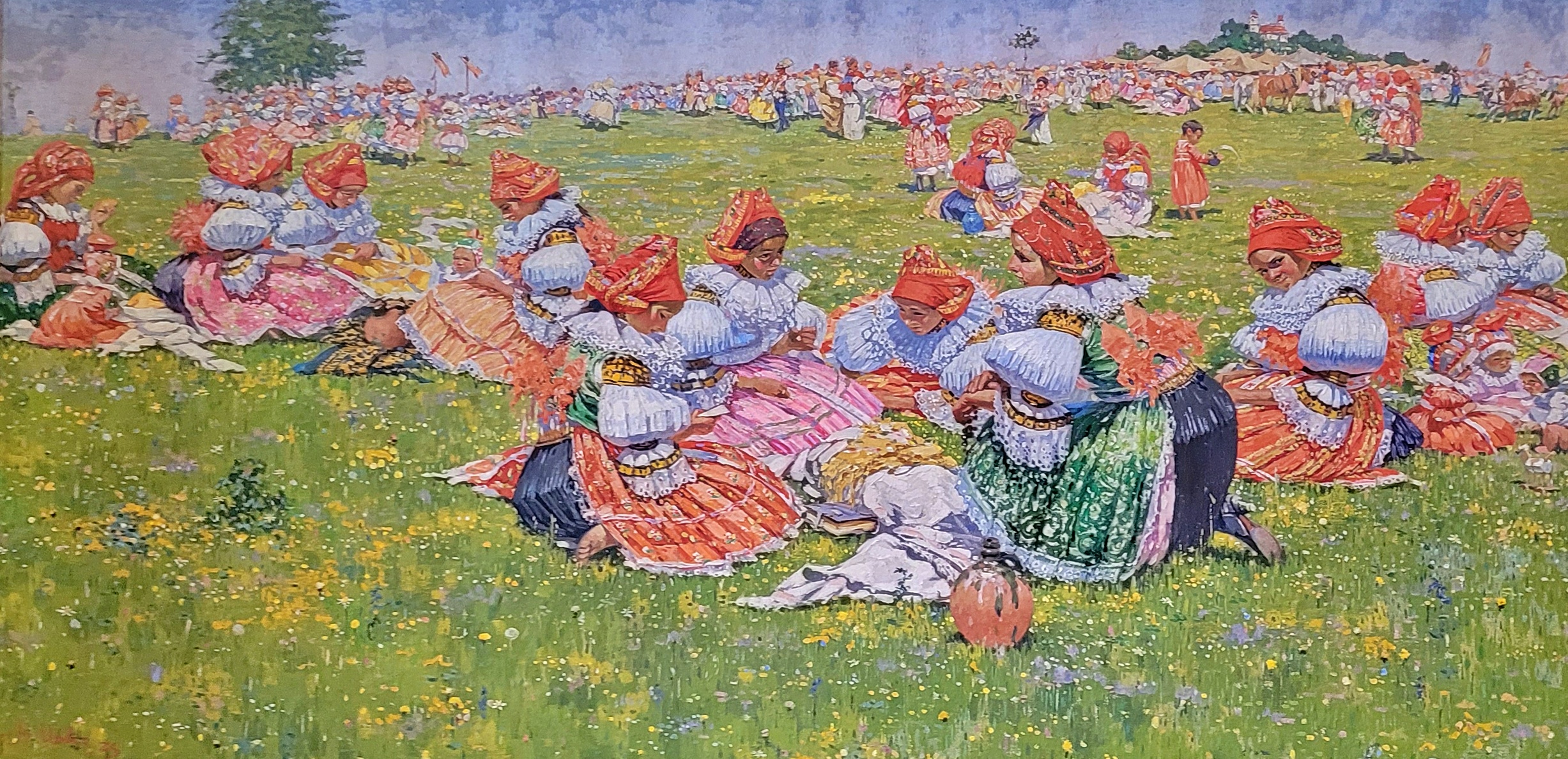
He was very fond of travelling and he was a true maverick. After his experiences, he was not very fond of the “Western Slavs”, as he called the Czechs, nor did he love Prague and the Prague people. He said he was taught “painting” at the Academy in Prague. 🙂 And they didn’t like him in Prague either. They called him a country bumpkin and didn’t invite him to art salons.
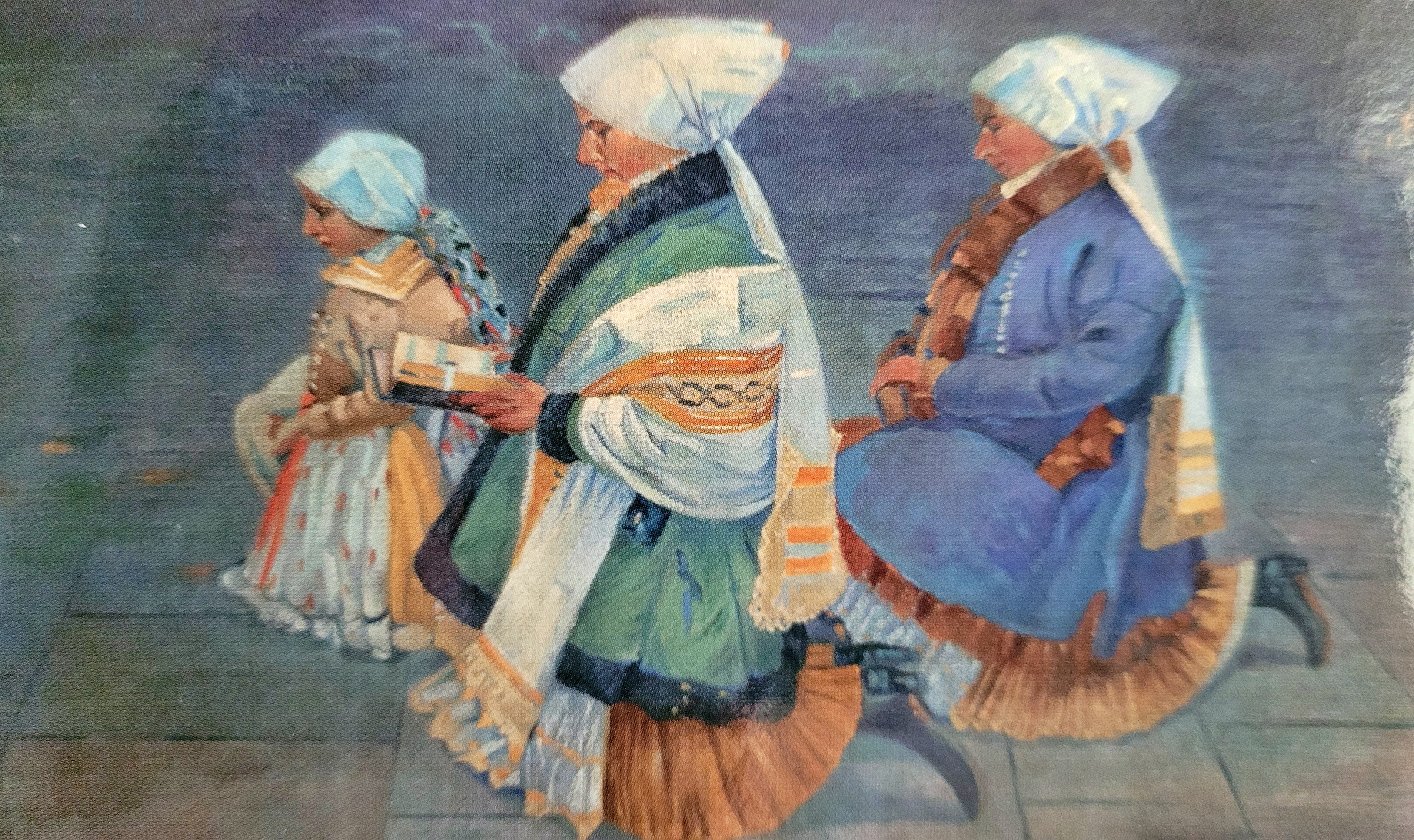

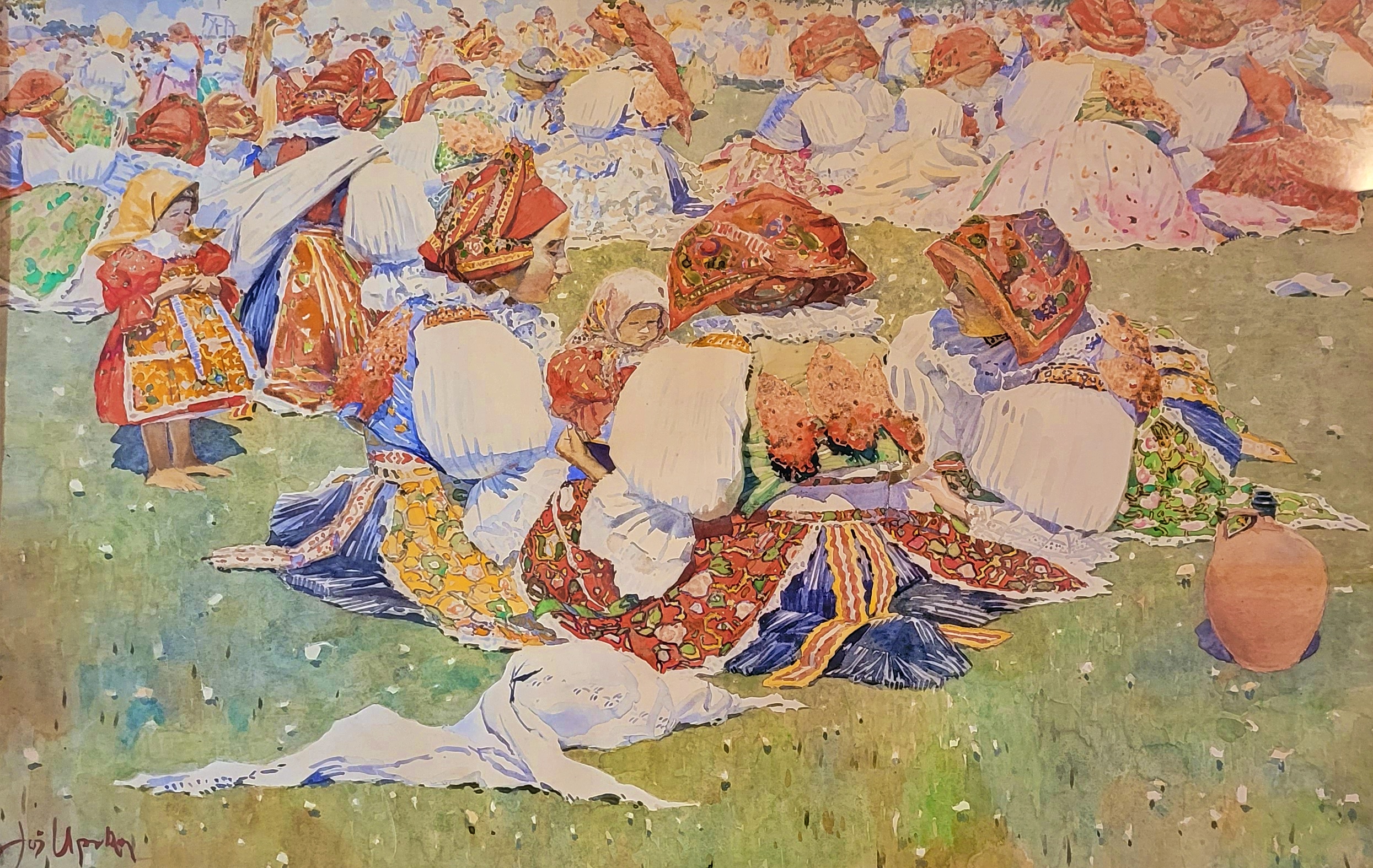
Uprka married the folk painter Anežka Karlíková from Svatobořice. He bought a plot of land in Hroznová Lhota, where he had his studio. Later he had it rebuilt according to the design of architect Dušan Jurkovič. Artists such as Alfons Mucha, brothers Alois and Vilém Mrštíková, Zdenka Braunerová, Leoš Janáček and even one of the most famous artists of his time, the French sculptor August Rodin, met here.
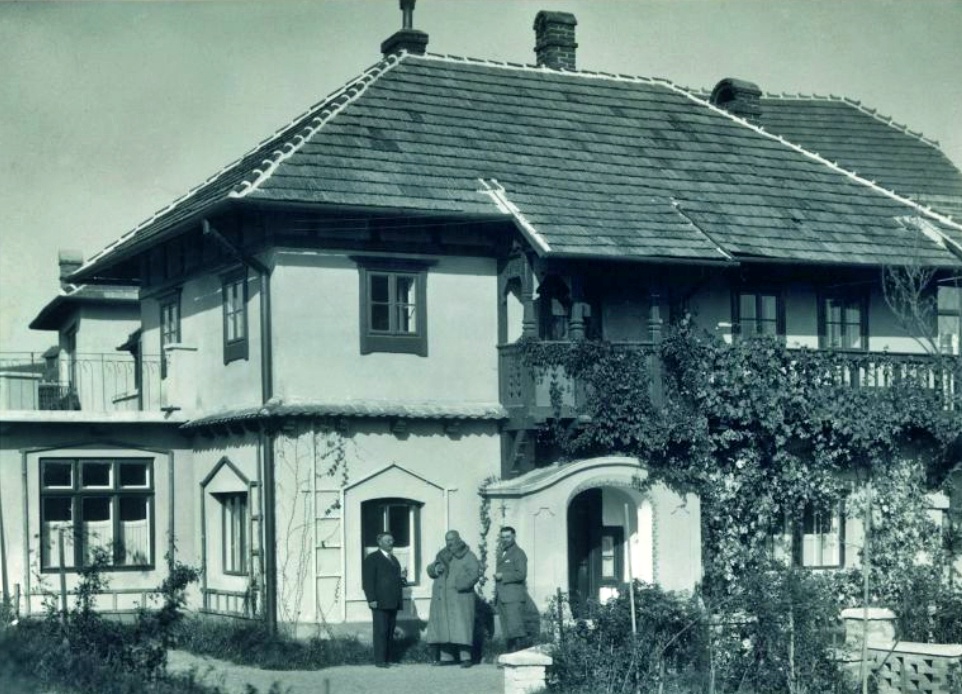
Because my wife had a mental illness, after 6 years of marriage she started to live in a psychiatric hospital in Kroměříž until her death (she was there for 54 years). He had four children with her. With the money from the Ride of the Kings he bought a castle with a park and an orangery in Klobusice near Ilava in Slovakia, where he moved. He lived there for 15 years and always liked to return to Moravia.
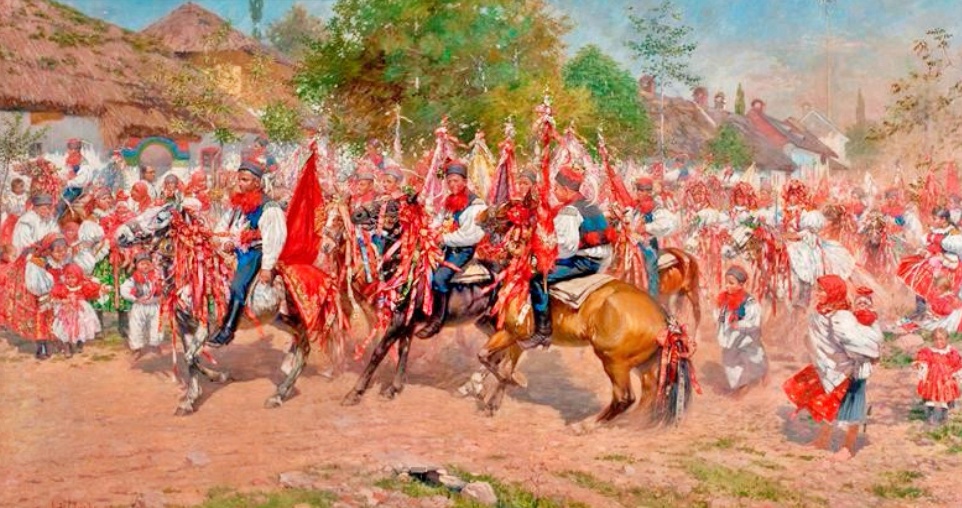
By the time he had fully returned home, he was already ill. The last years of his life were marked by the activities of his son Jan. He tried to take advantage of his father’s fame and co-founded the National Fascist Community. However, Uprka had nothing to do with the Nazis and never campaigned for them. He resented his son’s attitude. Nevertheless, he did not escape the attention of the Nazis.

This painting belonged to a wealthy Jewish family. No one knows whether the painting was confiscated by the Gestapo and later recovered by the family or whether it was preserved during the war. However, it is known that the Nazi leader K.H. Frank wanted it for himself.

Uprka died of kidney failure. His funeral was famous and he is buried next to his brother František at the so-called Slavonic Nightingale in his native Kněždub.
2. THE MUSEUM OF MORAVIAN SLOVAKIA
The museum of Moravian Slovakia in Uherské Hradiště occupies an important position in the network of Czech and Moravian museums. I have to admit that I was absolutely blown away by the museum. The main building of the museum is located in Smetana Gardens and is dedicated to the Slovácko exposition. The museum was created thanks to the enthusiasm of the patriotic inhabitants of the town.
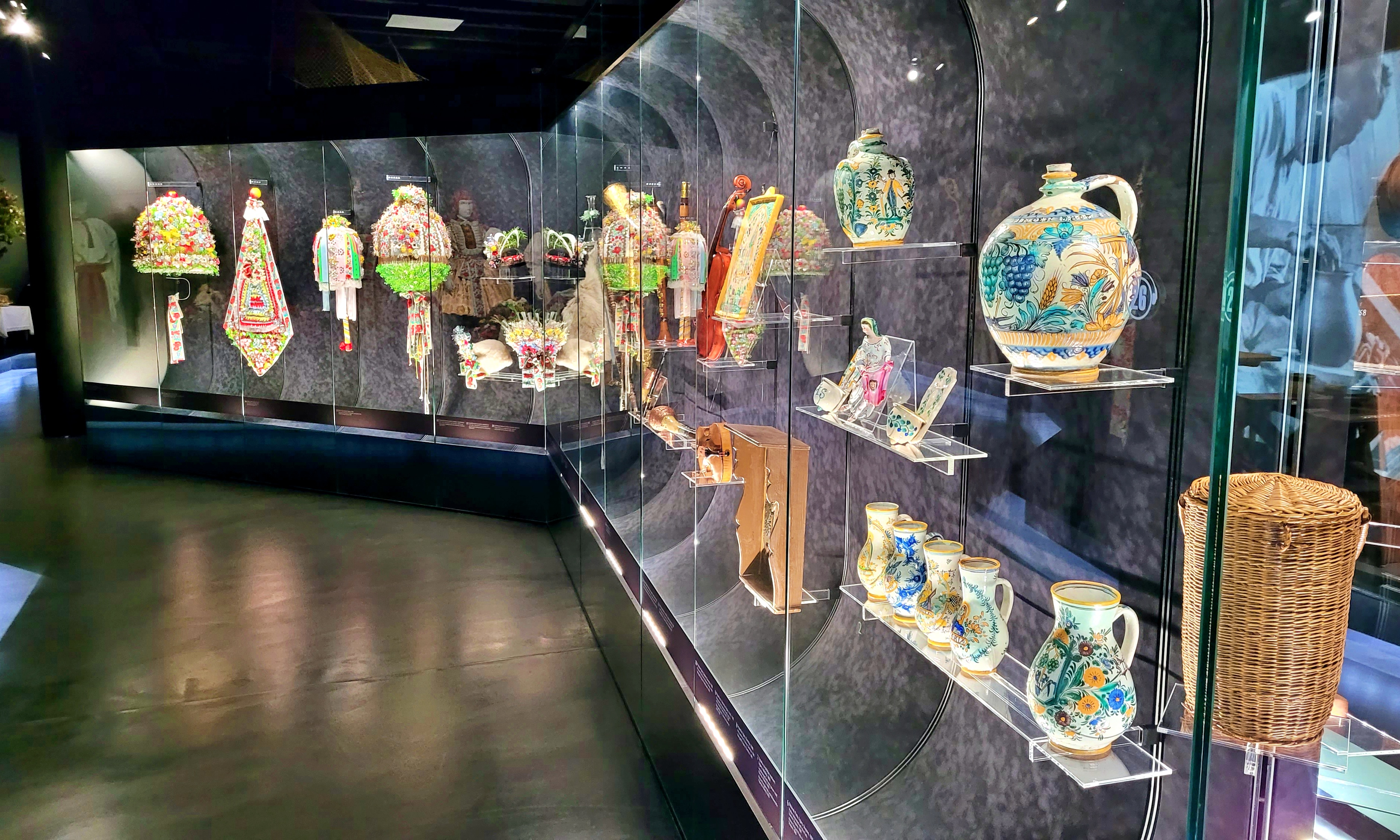
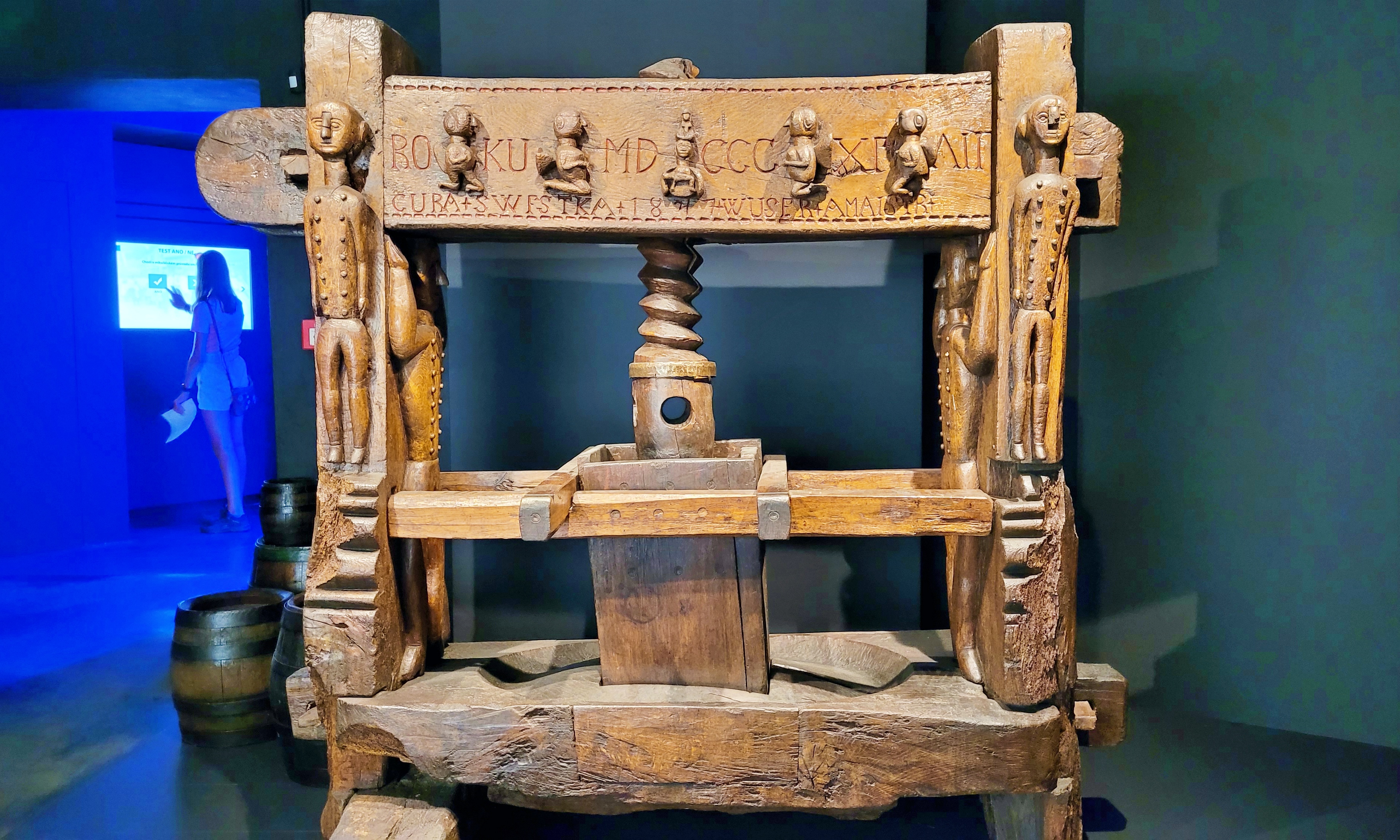

The exhibition is very nicely done. The ethnographic exposition is divided into several sections, which are interconnected and interlinked.You will get acquainted with different areas of rural life. The basic way of livelihood was agriculture, cattle breeding, beekeeping, pottery, woodcarving and viticulture. You will discover how many large families lived and learn about their customs.
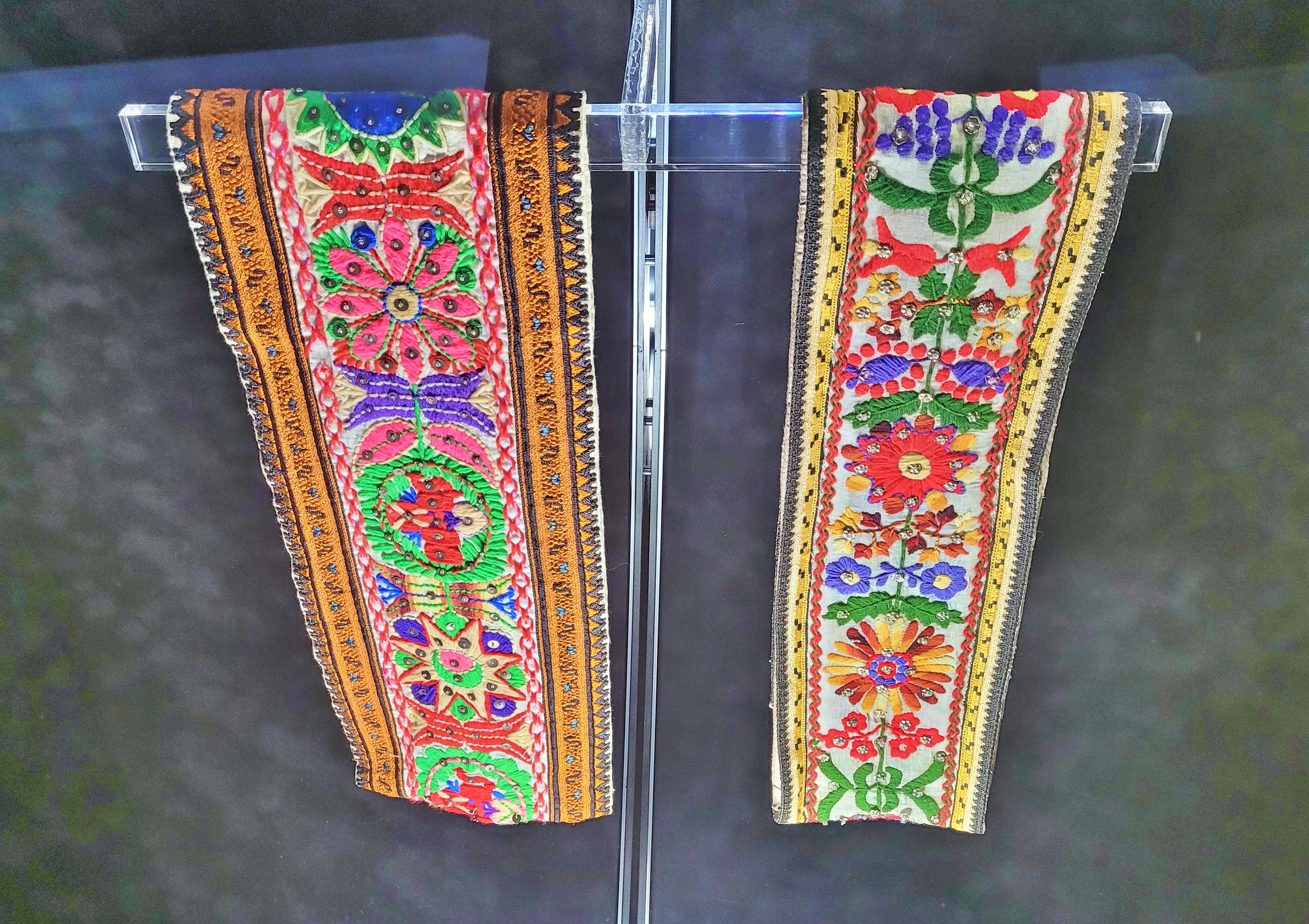
The King’s Pentle, Hluk 1920

The King’s Crown, Kunovice 1936
One of the most famous customs of the turn of spring and summer – Pentecost, known in the Christian calendar as Pentecost, is the “Ride of the Kings” in Slovácko. The main character of the ceremonial horse-drawn ride is the king dressed in women’s costume and his retinue of bachelors.
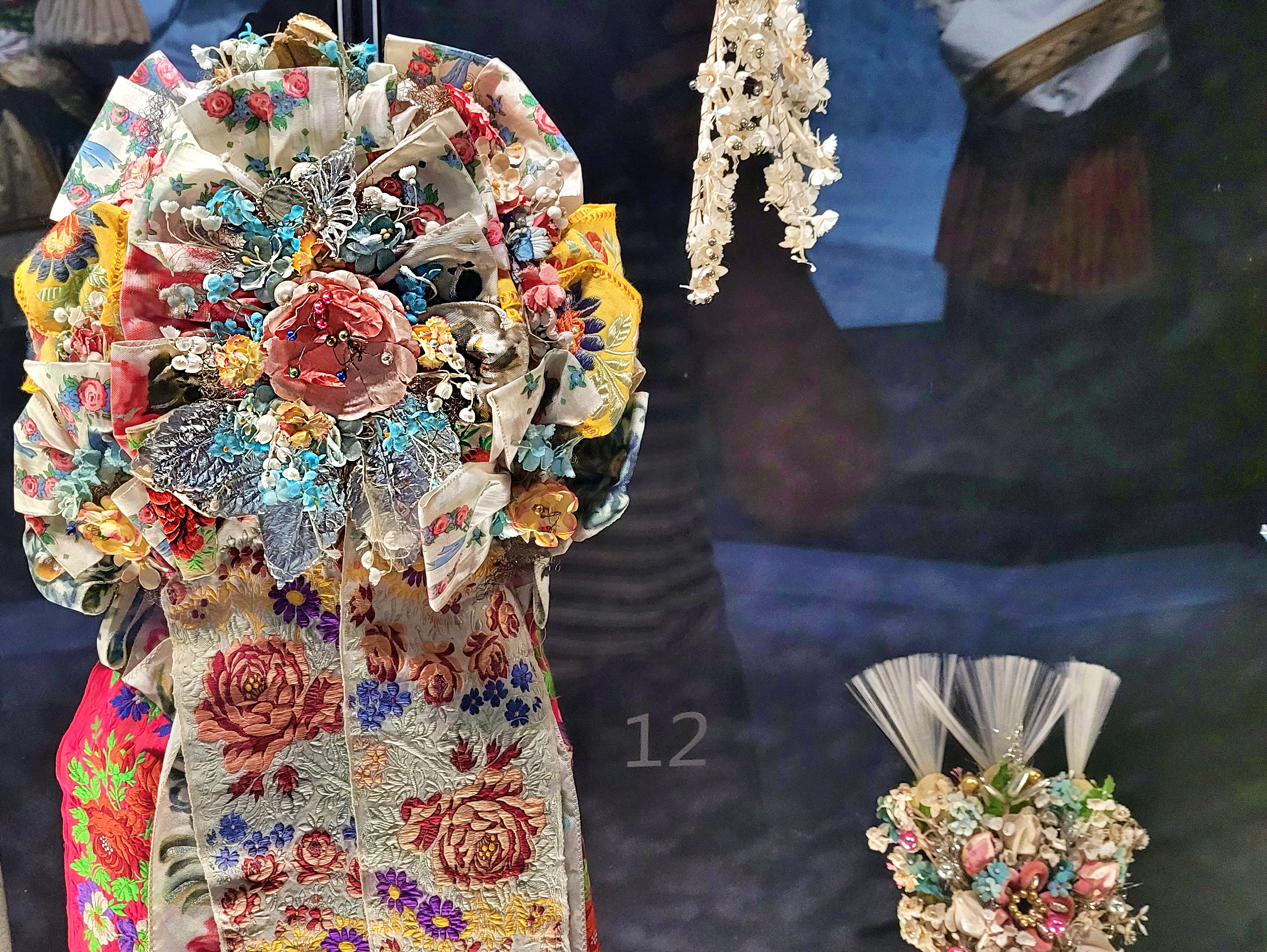
The bride’s braid. Uherský Ostroh, 1890
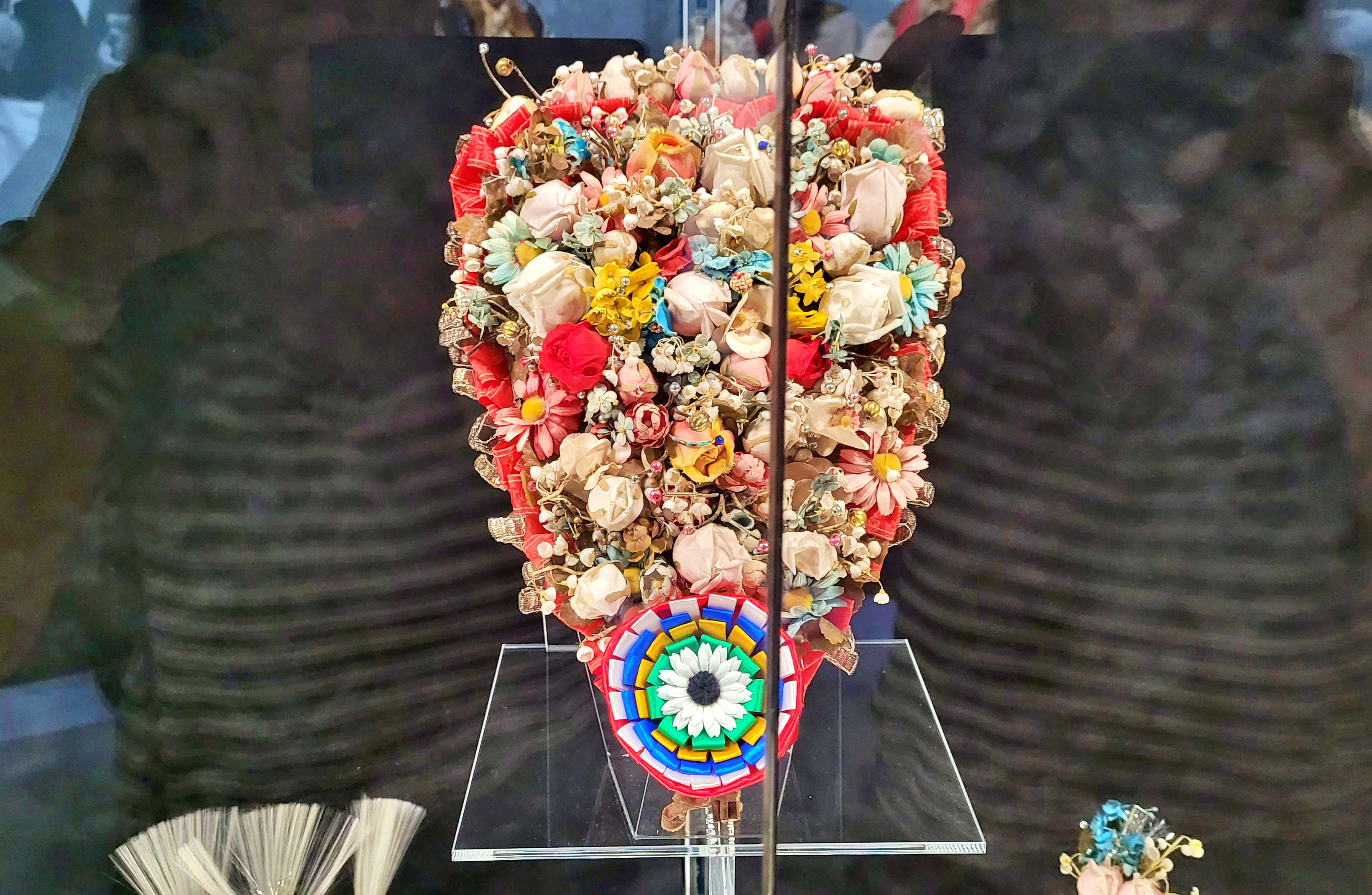

Front skirt of women’s costume – aprons, decorated with blue print. Moravian Kopanice, mid-19th century.

Blueprint mould, Veselí nad Moravou. 1820, blueprint specimen – antler pattern. Strážnice. 1960

The form on the skin. Bojkovice. 1860
FOLKLOR COSTUMES OF SLOVÁCKO
The section devoted to Slovak costumes is also nice. Here you will realize how diverse Slovácko is. Here you will find costumes from the mountainous regions of Moravian Kopanice through the foothills of Buchlovice, Luhačovice Zálesí, Uherskobrodsko, the Lower Hradiště and Kyjov regions to the flat Podluží and the surroundings of Strážnice.
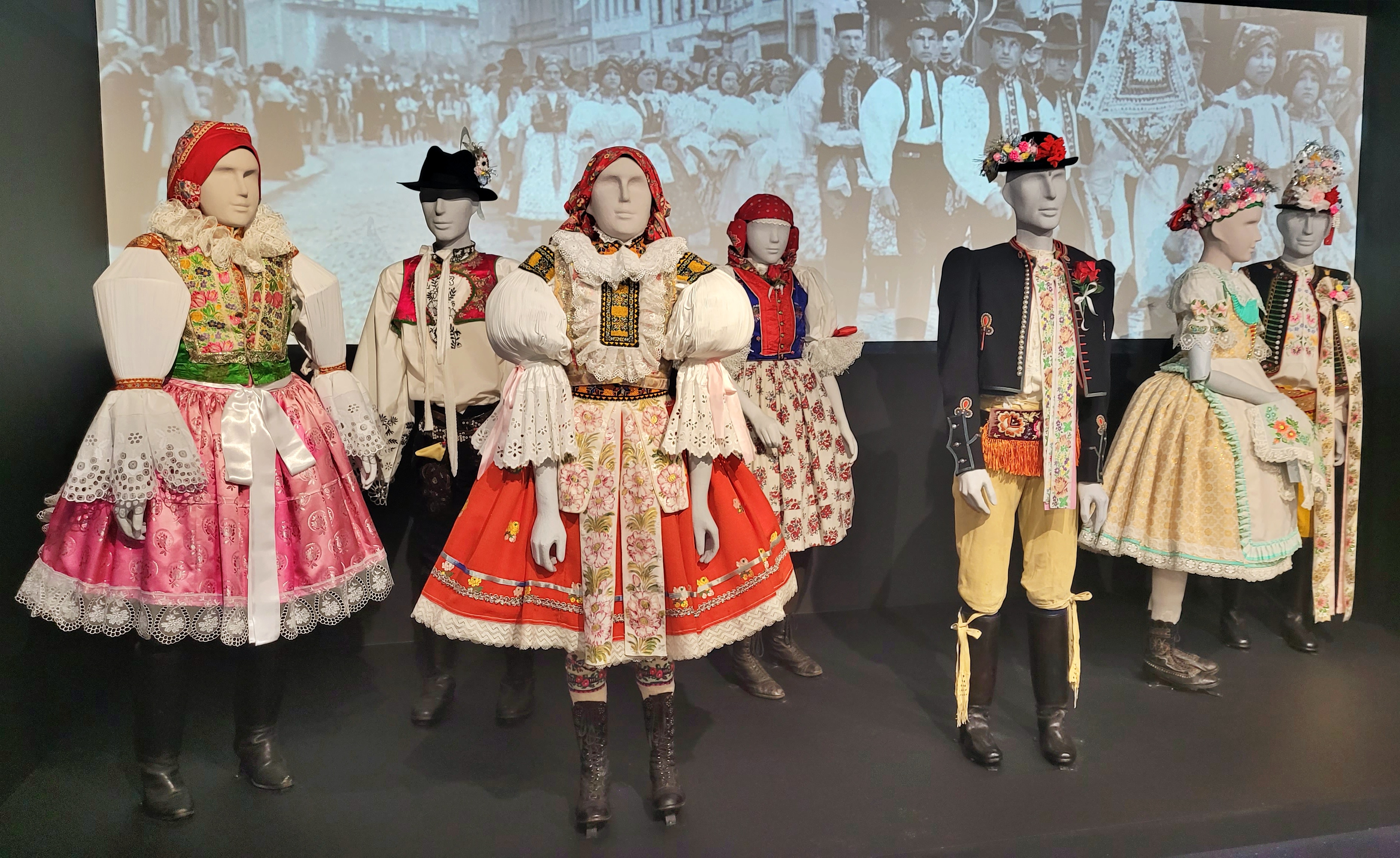
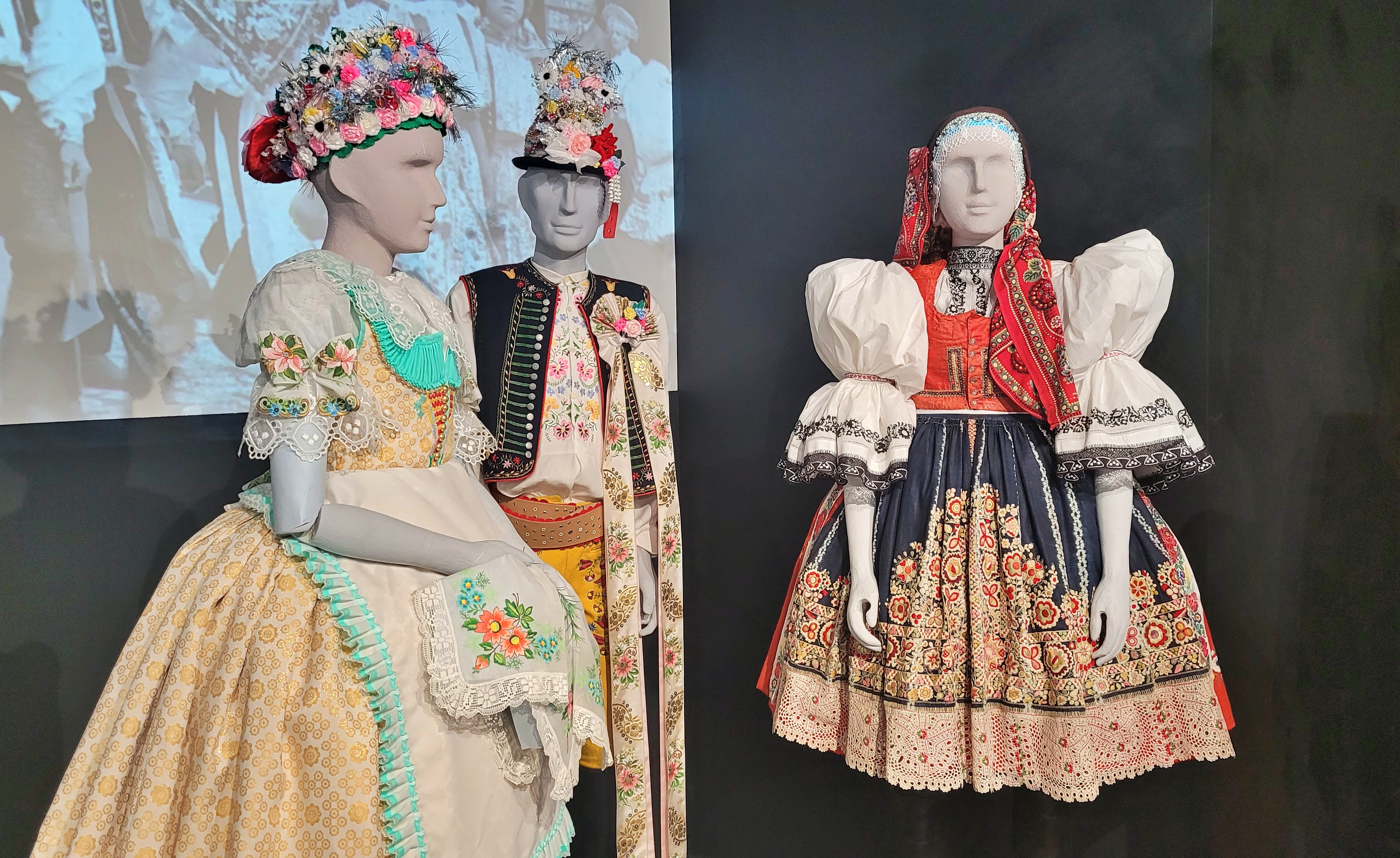
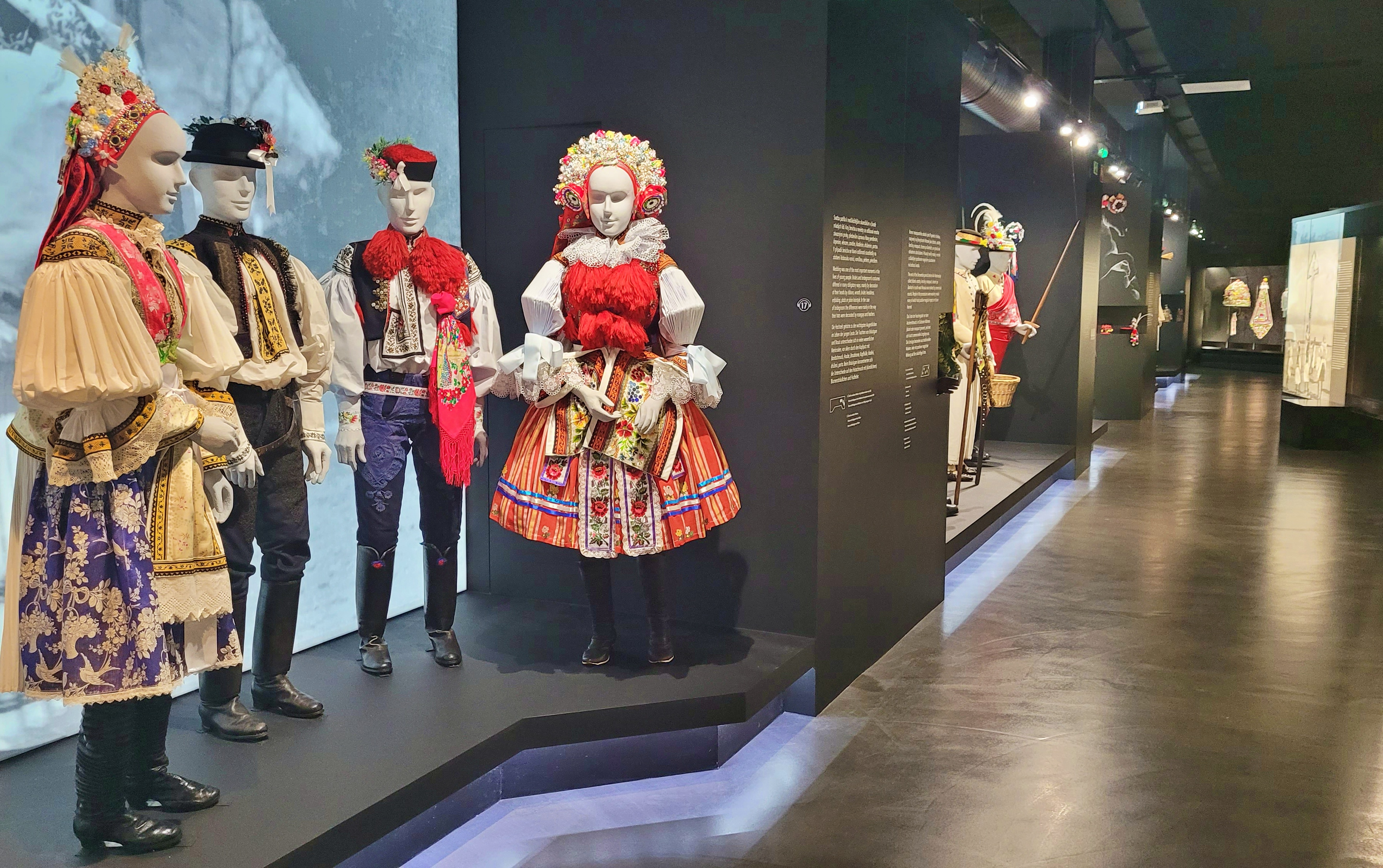
One of the oldest skills was working with clay. Vessels were made for everyday cooking and food preservation. Local craftsmen made plates, jugs, bowls, pots, pans and moulds for various types of baked goods on the potter’s wheel.
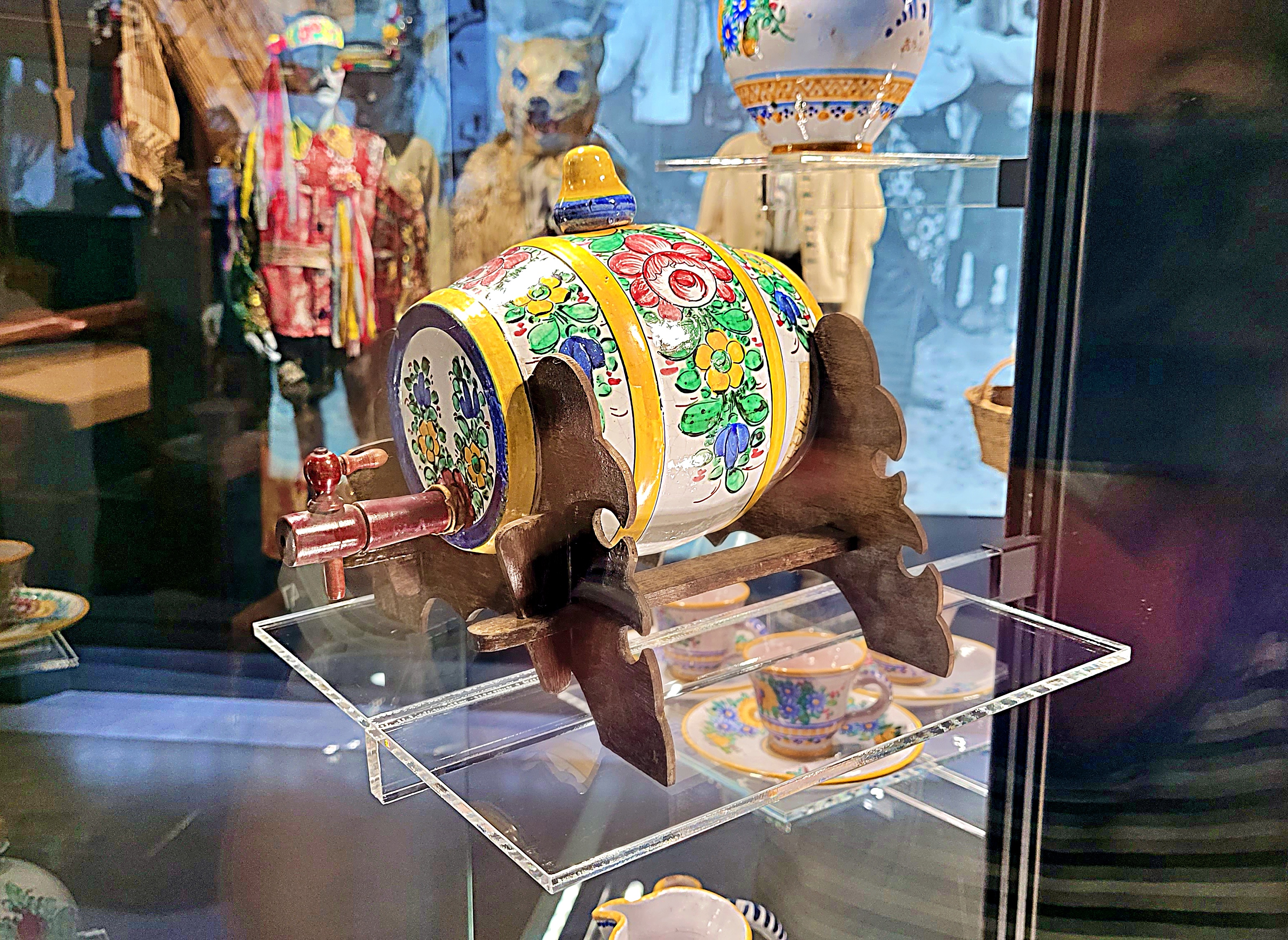
A keg of fajanas. Workshop of Oldřich Úředníček. Tupesy. 1940
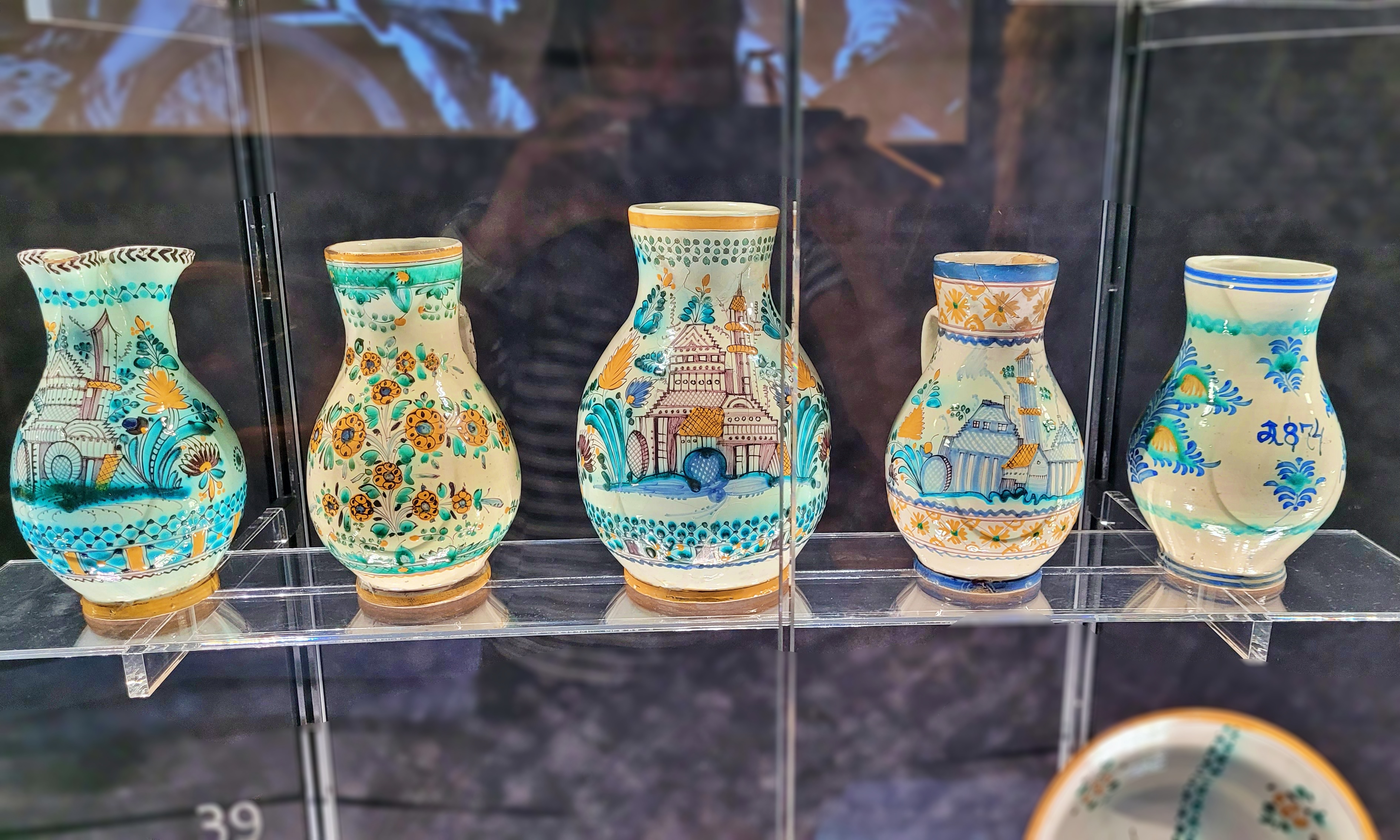
Pitchers, faience. Sobotiště.1820 – 1840

Pitcher with field work motif, faience. Stupava, 1870
TRY ON THE COSTUME
You can try on the costume to see how it would suit you. You have to stand on the marked spot in front of the screen. You put your arms out to the side and twist at the waist, the figure should follow you. But for me, the male costume came up all the time. So I don’t know what I was doing wrong. Or am I missing something? 🙂

I really liked that the whole exhibition is complemented by multimedia elements, various animations and short films. You can watch video recordings and listen to audio recordings of folk culture. A short slideshow gives you an overview of the different sub-regions in several slides, including typical musical accompaniment by selected performers from each region. And that’s really great!

At the end, you can test your knowledge about the life of the people in Slovácko in interactive tests. And sometimes it’s not easy. 🙂
3. MONUMENT OF GREAT MORAVIA
The memorial is located on the Square of Great Moravia in the Old Town near Uherské Hradiště in the middle of the archaeological site Na Valách, in the place where Veligrad, one of the centres of Great Moravia, used to be. The monument to the Great Moravian Empire in Old Town was built over the foundations of a 9th century cemetery church discovered by archaeologist Vilém Hrubý in 1949. It is the first ever proven stone Great Moravian building in Moravia. The church building was surrounded by a large burial ground in the Great Moravian period. Members of the Great Moravian Empire with weapons and jewellery, as well as poor people, farmers and craftsmen were buried here.
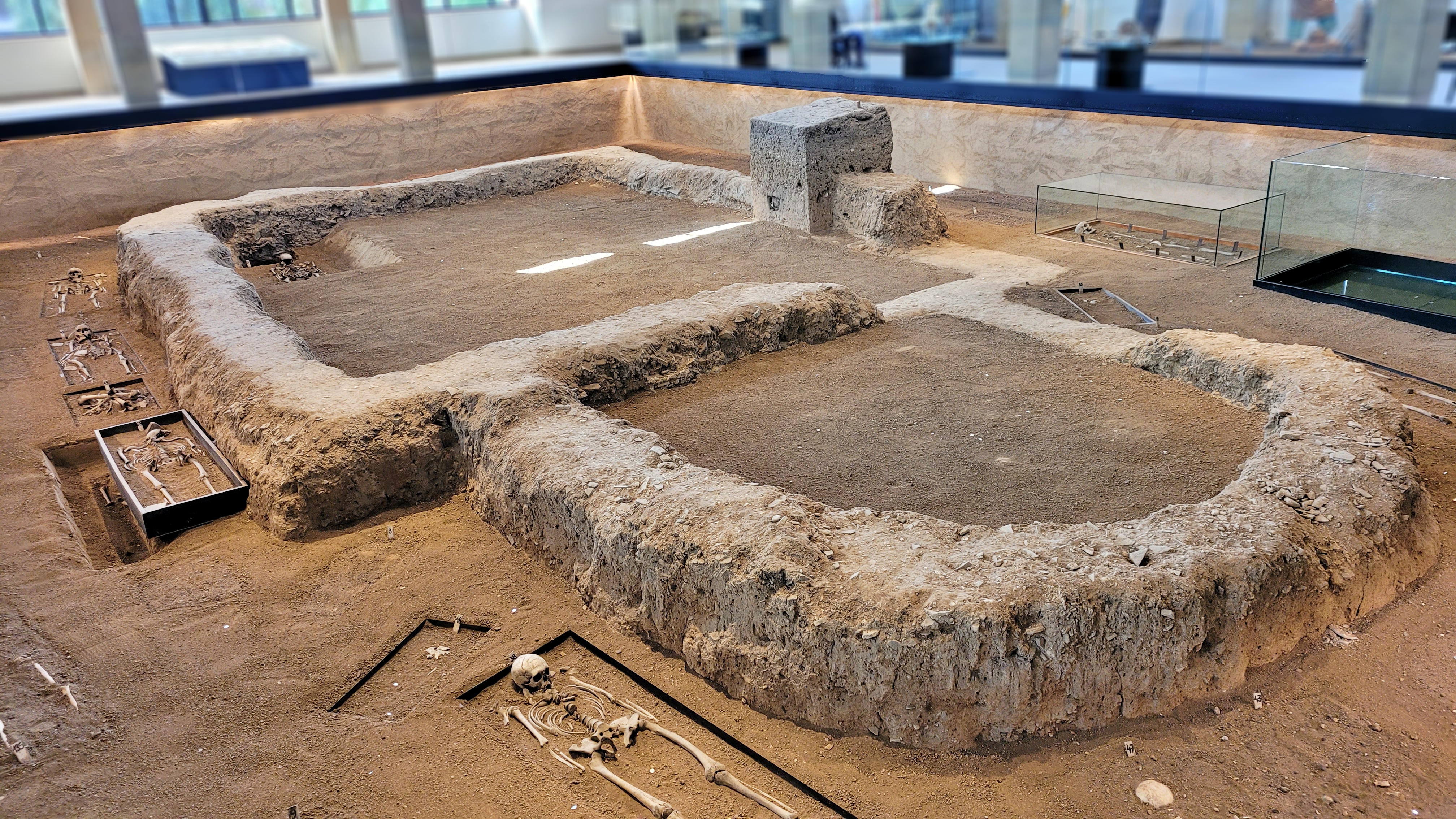
You can see replicas of period clothing, shoes, rare jewellery, work tools and other finds.

And why Old Town? Few people realise that Veligrad is a site comparable in historical importance to Vyšehrad, Hradčany or Hostýn. According to medieval chroniclers, it was the seat of the Great Moravian rulers Mojmir, Rostislav and King Svatopluk, and it is the place where the saints Cyril and Methodius came and worked.
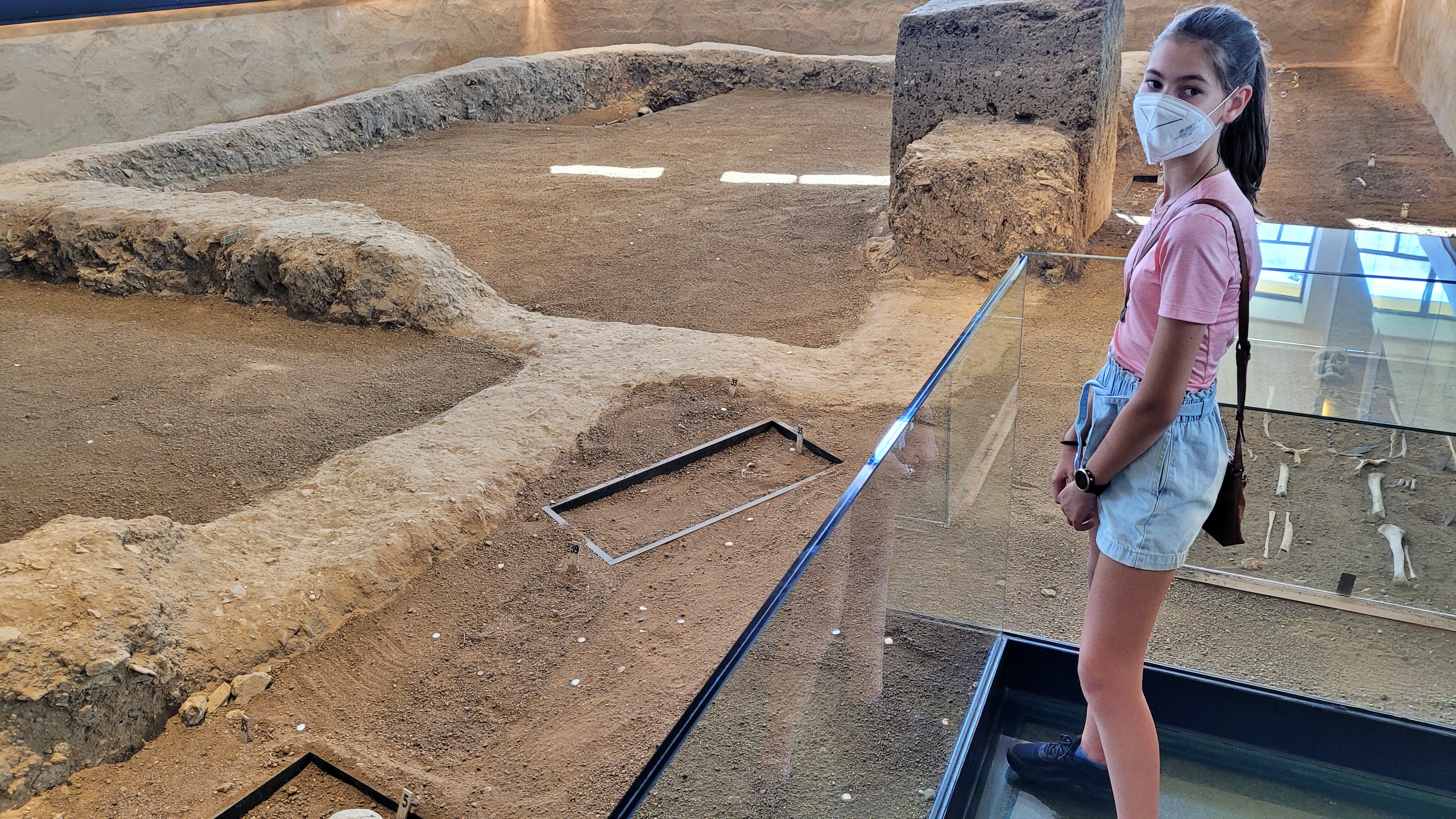
The main exhibit is therefore the remains of the church with an adjacent burial ground with several uncovered graves. There is even a child’s grave. Around it are showcases with valuable finds from various areas of activity of the Great Moravian man.
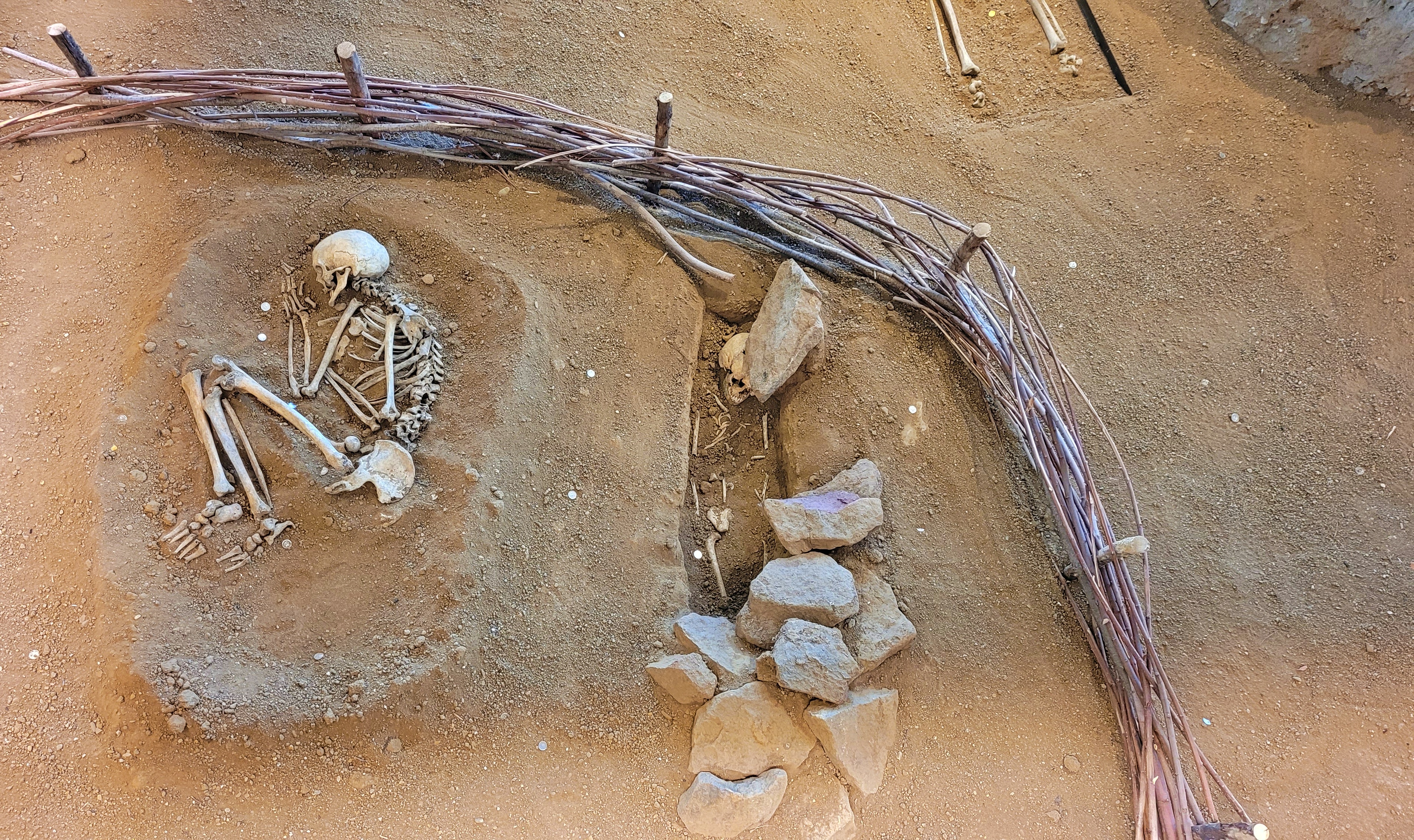
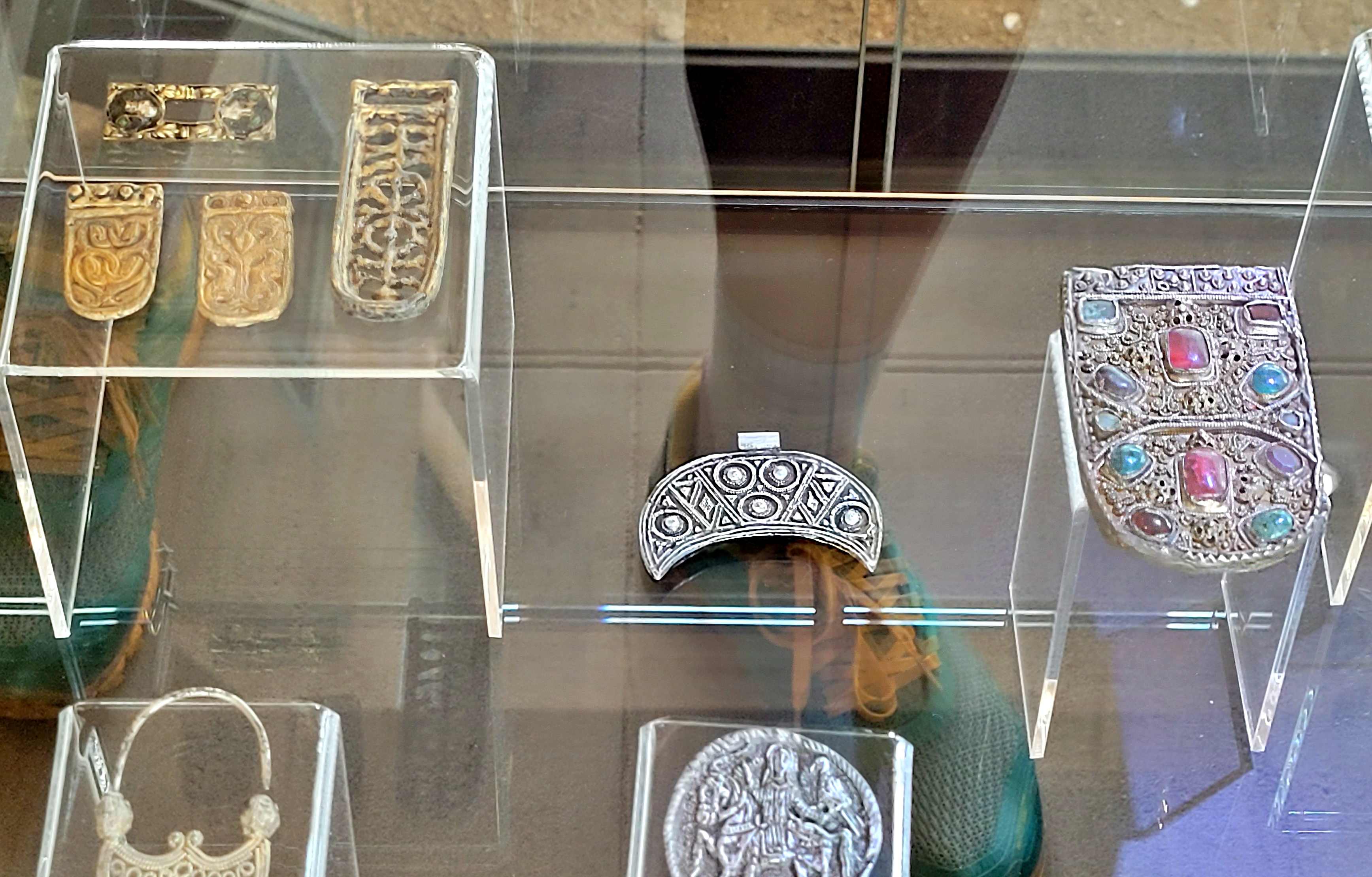
VAMPIRE’S GRAVE
What caught my attention is that there are also graves of so-called vampires. These were individuals who were somehow out of the mainstream of society at the time. They were people who were probably feared by the rest of society, which was reflected in the subsequent burial ritual. Over these buried vampires were piled mounds of stones. They were posthumously stoned in the head. They were buried in atypically narrow grave pits. They were probably mentally ill people.
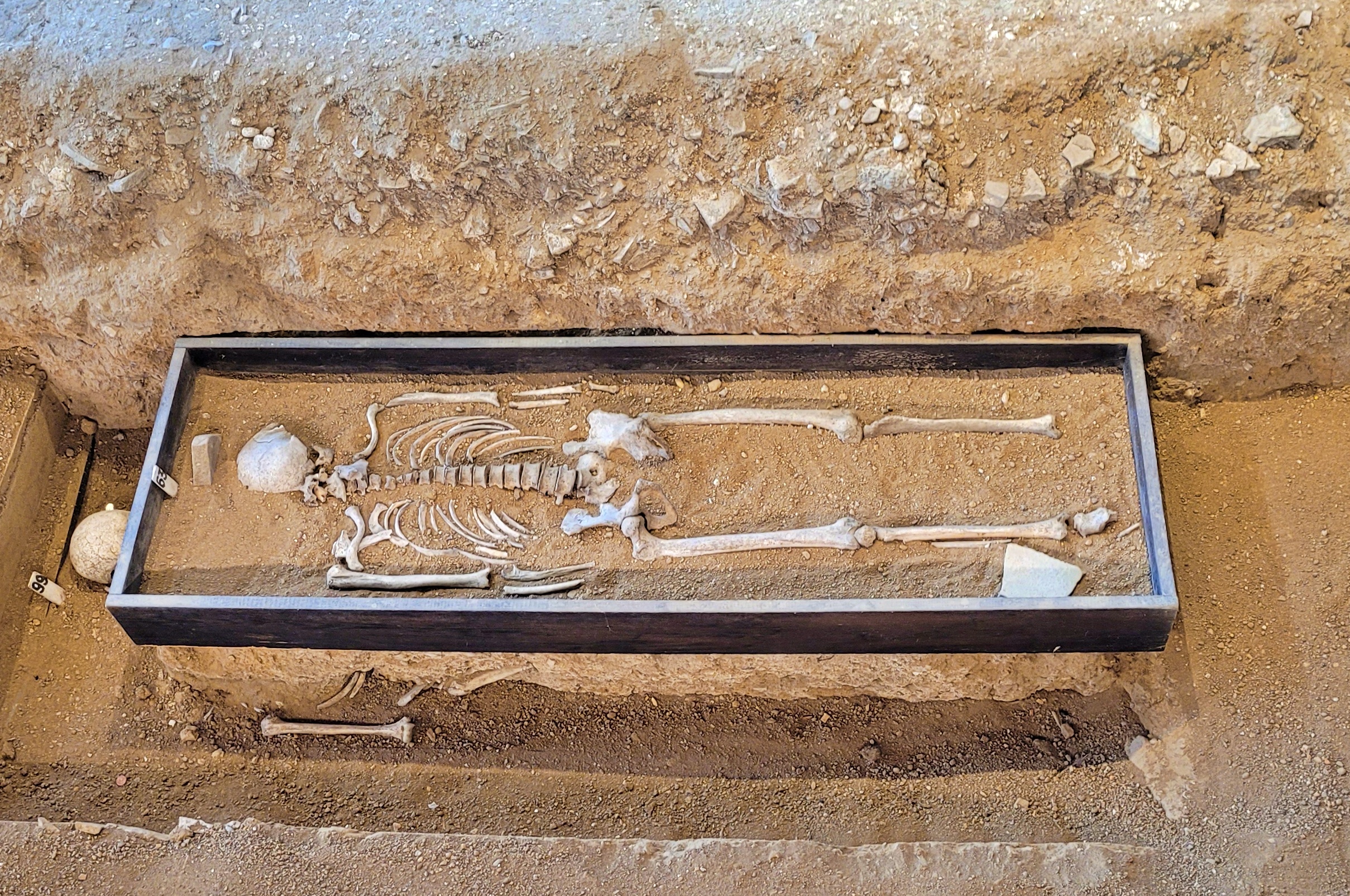
In addition to church foundations and graves, you can see period clothing and footwear, weapons, jewellery, craft tools and model reconstructions of a Great Moravian settlement.
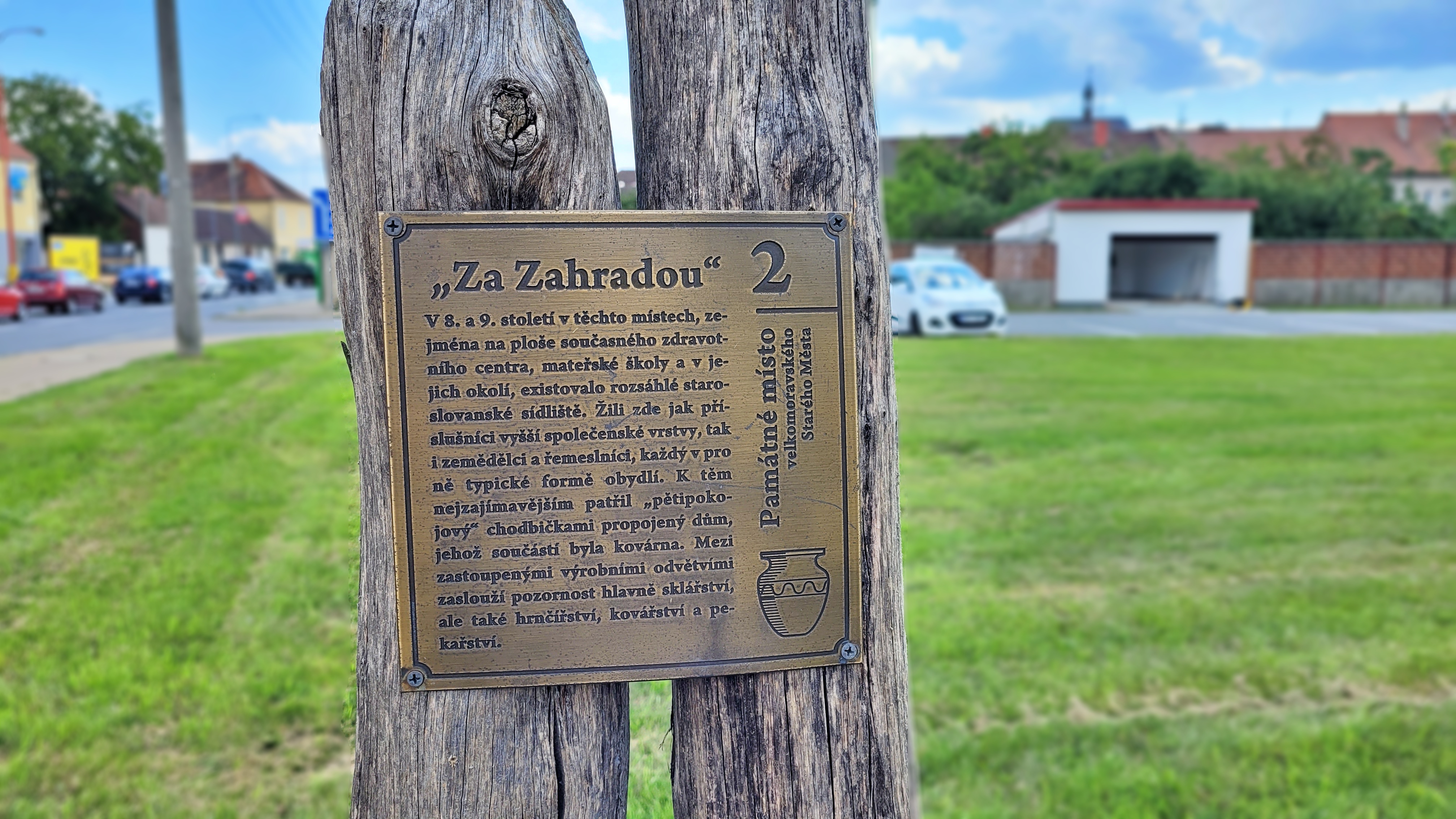
So what? Did you like the article behind the traditions of Slovácko? If you liked the article, I will be glad if you share it or leave a nice comment under the article.
I would also like to invite you to join me on Instagram a Facebook.

